Executive Summary
The purpose of the report is to compare Cessna 150’s fuel system with that of Piper PA-28 Cherokee in terms of performance, efficiency, and cost. Both systems use the same working principles. Fuel for the flight is initially stored in the tanks located in the right and the left wings of both aircraft. There are minor differences in terms of the components of the two systems. However, the functions performed are the same. Assessment criteria used for the comparison of the two systems are the performance, cost, and efficiency.
The Piper PA-28 Cherokee’s fuel system performs better compared to that of Cessna 150 given that it is able to lift more weight. The former is also efficient in the utilization of fuel. On average, both systems inject 9 gallons of fuel into the engine. However, the Piper PA-28 Cherokee is a larger private plane model compared to the Cessna 150.
The cost of the former is also higher in comparison to that of Cessna 150. Piper PA-28 Cherokee is the most preferred system according to the report. The decision was arrived at following an analysis using the efficiency vs. cost criteria.
Purpose
The purpose of the report is to compare Cessna 150’s fuel system with that of Piper PA-28 Cherokee with regards to performance, efficiency, and cost. Both machines are classified as light aircraft. They are used mainly for touring and training. Cessna 150’s fuel system comprises of three major parts. The parts are made up of the fuel tank, sump trains, fuel gauges, the strainer, and the carburetor. Piper PA-28 Cherokee’s system, on the other hand, has a fuel tank, a fuel gauge, a sump, and a fuel pump.
The components are the most significant parts of the system. Unlike Piper PA-28 Cherokee, Cessna 150 has a shut-off valve to control the flow of fuel to the engine. Piper PA-28 Cherokee, on its part, uses the pump to regulate the flow of fuel to the engine. Both fuel systems are made up of two tanks within the wings.
Each tank in Cessna 150 has a capacity of 19 gallons. In total, the aircraft has a fuel load of 38 gallons when filled to capacity. On the other hand, Piper PA-28’s tanks have a capacity of 25 gallons each, with tip tanks carrying 17 gallons. As such, when filled to capacity, the aircraft has a total of 84 gallons of fuel
Cessna 150’s fuel system
Invention
The fuel system was first designed in 1951 when the production of the aircraft started. It was designed by Reims Aviation. The production of the aircraft’s fuel system was done in the United States.
Developmental history
Since the production of the first aircraft, there have been continuous efforts to improve the fuel system. The changes have mainly been implemented in the new variant of the aircraft model. Some of the modifications that have been made on the system over the years include the introduction of vent lines to control the flow of fuel from the tank to the engine, as well as to avoid leakage.
The figure below shows how the vent lines are modified to avoid fuel leakage:
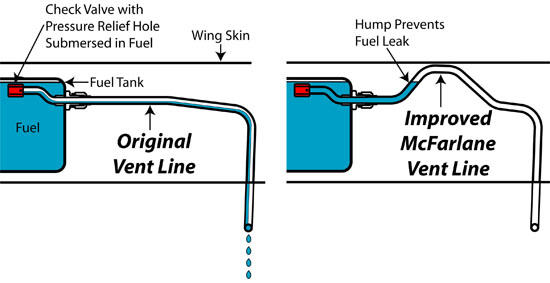
Socio-economic context
Cessna 150 system allows for the efficient use of fuel compared to other light aircraft. As a result, it allows the public to enjoy cheap flights. The aircraft is also the preferred model in conducting training and for private flights.
Major manufacturers
Reims Aviation and Dawson Aircraft Inc. are involved in the manufacture of the aircraft’s fuel system. Most of the production activities occur within the United States of America.
Cost
The estimated cost of the aircraft’s fuel system is US$1000. Most of the cost is related to the purchase of the tanks, which are the major components of the system. Each tank costs US$450.
Piper PA-28 Cherokee’s fuel system
Invention
The system was invented in 1960 when the aircraft was first produced. It was invented by the Piper Aircraft in the United States of America.
Developmental history
Over the decades, the aircraft’s fuel system has been improved continuously. One of the most notable improvements is the introduction of an electric fuel pump. Initially, fuel used to move from the tanks to the engine through gravitational force. The introduction of the pump increased the system’s efficiency by controlling the amount of fuel flowing into the engine.
Socio-economic context
The system is associated with the efficient use of fuel. As a result, flight costs are reduced, which makes it desirable, especially in relation to private flights.
Major manufacturers
Dawson Aircraft Inc. is the major manufacturer of the fuel system. Most of the manufacturing activities are carried out within the United States of America.
Cost
The estimated cost of the system is US$1800. The fuel tanks account for the largest share of the cost. The cost of a single tank is estimated to be US$695. An additional cost of US$150 is incurred in the purchase and installation of the fuel pumps. Additional costs are in terms of fuel passages and wiring.
Mechanism Descriptions
Cessna 150’s Fuel System
The appearance of Cessna 150’s fuel system
Most of the components of the system are contained in the wings. The fuel tanks are fitted with outlets that lead to the engine. The tanks are designed to fit into the wings of the aircraft. As such, they are shallow and wide in appearance. They are filled through a hole on their top surface.
The figure below illustrates Cessna 150’ fuel tank in one of the wings:
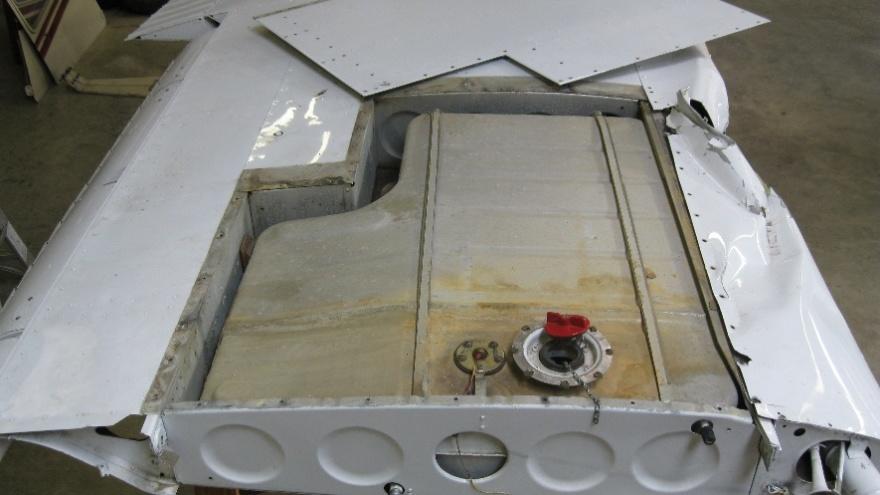
The figure below illustrates a fuel strainer used in Cessna 150’s fuel system:
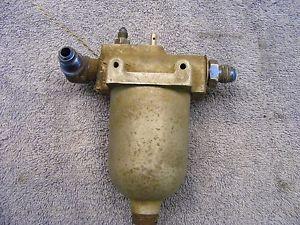
The figure below shows the fuel shut-off valve used for controlling the entry of fuel into the engine:
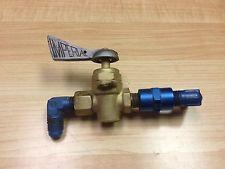
The diagram below shows a fuel filter used for priming purposes:
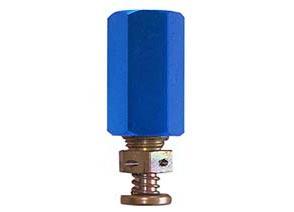
The Components of Cessna 150’s Fuel System
The major components of Cessna 150’s fuel system include the right and left fuel tanks, the shut-off valve, the strainer, and the carburetor. Other parts include the intake manifold, the sump trains, and the fuel gauges.
Operations of Cessna 150’s Fuel System
The operation of the system involves drawing fuel from the tanks. The shut-off valve regulates the amount of fuel drawn from the tanks for passage into the engine cylinders. The fuel passing through the shut-off valve moves to the strainer before it is injected into the engine cylinders.
Piper PA-28 Cherokee’s System
System Appearance
The most prominent features of the system include fuel tanks. They are located in both wings. As such, they assume the design of these structures. The aircraft has larger wings compared to Cessna 150. The size allows for the use of large tanks in the system. All the other components are attached to the fuel tank.
The figure below illustrates a section of the wing that acts as the fuel tank:
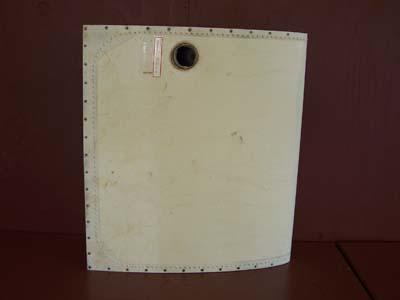
The figure below shows the electric fuel pump used in the delivery of fuel into the engine cylinders:
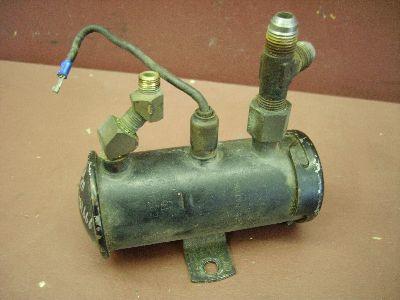
The Components of Piper PA-28 Cherokee’s System
The system consists of two fuel tanks, two fuel gauges, sump drains, and a fuel pump as the most prominent parts.
Operations of Piper PA-28 Cherokee’s System
The tanks act as the storage for the aircraft’s fuel reserve. Each of them has its own gauge to monitor fuel levels. Fuel is normally drawn from the tanks by the pumps. The sump drains play a role in the removal of waste fuel that settles at the bottom of the tanks.
Comparative Analysis
Operational Goal
The fuel system of an aircraft plays a major part in its propulsion. It plays the role of storing and delivering fuel to the engine cylinders. Some of the qualities of the system that should be taken into consideration include the capacity of the tanks. The efficiency in the utilization of fuel is also an important aspect of the system. It is computed in terms of gallons of fuel used per hour.
Assessment Criteria
Performance
There is a close relationship between the performance of an aircraft and its fuel system. Cessna 150 carries a considerably smaller amount of fuel compared to Piper PA-28 Cherokee. It has a cruise speed of 109 knots. The aircraft’s reduced fuel capacity is due to the fact that a large space is dedicated to the storage of luggage. The speed can be achieved even when the aircraft is lifting a weight of 726Kgs, which is equivalent to 1600lbs.
The aircraft can handle a maximum weight of 757 kilograms in spite of its small size. The presence of the fuel shut-off valve helps avoid blockages. The development makes the aircraft safer compared to Piper PA-28 Cherokee. As a result, few accidents associated with the malfunction of the fuel system are recorded in this model. The 3 gallons of fuel per tank conserved only for use in emergency cases also help in safe landing, something that reduces fatalities.
Piper PA-28 Cherokee, on the other hand, has a higher fuel capacity compared to Cessna 150. Subsequently, it has a higher consumption rate than Cessna 150. The aircraft has a top speed of up to 132 knots. It is able to cruise at this speed while lifting a weight of up to 2400lbs. When free, the aircraft weighs 1230lbs with its fuel tanks filled to capacity. It has the capability to lift a load that is almost as heavy as the machine itself.
The pump ensures that there is a constant supply of fuel to the engines. However, cases of blockage of the fuel passages are common, mainly as a result of the presence of contaminants. The blockages can lead to serious accidents. As such, the aircraft is considered to be less safe compared to Cessna 150. In addition, its fuel system has no allowance for emergency reserves. Accidents associated with fuel shortage are, as a result, more frequent compared to those recorded in Cessna 150.
Efficiency
Cessna 150’s fuel system is considered to be more efficient than that of Piper PA-28 Cherokee. The main reason for this is that the fuel shut-off valve regulates the amount of fuel passing into the engine. On average, the aircraft consumes between 8 to 12 gallons of fuel per hour, even when carrying maximum weight and at peak speed. As such, the model can fly for up to 3 hours before stopping to refuel. The aircraft can remain airborne for up to 300 miles without the need for refueling.
On the other hand, Piper PA-28 Cherokee has a higher fuel consumption rate than Cessna 150. It is estimated that the plane can consume between 8 and 9 gallons per hour. As such, it can cruise for up to 5 hours without having to stop for refueling. As a result, Piper PA-28 Cherokee can travel a distance of 605 miles when its fuel tanks are filled to capacity. The electric pump used in the aircraft’s system also allows for the efficient control of fuel into the engine. As a result, wastage is avoided.
Cost
The tank is the most expensive part of an aircraft’s fuel system. All the other components of the system are attached to the tank. It is estimated that the cost of Cessna 150’s fuel tank is US$450.
In addition, the use of the system requires minimal maintenance costs. The shut-off valves used to deliver fuel to the engine operate under high pressure. What this means is that there are reduced instances of blockage. In addition, the valves mainly rely on gravity, reducing the cost of power required to operate the system. The labor requirements for the installation of the fuel system into the aircraft are estimated to be 25 hours.
On the other hand, the cost of Piper PA-28 Cherokee’s fuel tank is US$695. The electric fuel pump used in the system costs an additional US$150. As a result, the fuel system is almost twice as expensive as that used in Cessna 150. A lot of power is also needed to run the electric fuel pump. However, the time required for the installation of the fuel system is lower than that needed in Cessna. The process takes 6 to 8 hours. In terms of labor requirements, the system is cheaper than the one used on Cessna.
Discussion
How well Cessna 150’s Mechanism Meets all of the Criteria
The system is very popular in the aviation industry, especially on private aircraft. The design is simple and yet associated with high performance. It is capable of powering the aircraft to lift a load of 1600lbs. The aircraft is also able to cruise at 109 knots carrying the same amount of load. Minimal blockages in the system reduce the risk of fuel related accidents. In addition, conserved fuel helps power the aircraft during emergencies.
The shut-off valve helps in the efficient use of fuel by the aircraft, cutting on costs. The aircraft can remain airborne for up to 3 hours without the need to refuel, which makes it desirable for private use and in training. The system is cheaper compared to that used in Piper PA-28 Cherokee. It costs approximately US$450 compared to Piper PA-28 Cherokee’s system, which is US$695. Minimal maintenance is also required for the fuel passages. As such, the maintenance costs are reduced considerably.
How well Piper PA-28 Cherokee’s Mechanism Meets all of the Criteria
Piper PA-28 Cherokee’s fuel system is desirable, especially for the powering of light aircraft. The system has tanks that can carry up to 84 gallons of fuel when filled to capacity. The fuel is enough to propel the aircraft for 605 miles when carrying a weight of 2400lbs. The aircraft’s fuel system is also efficient.
It requires approximately 9 gallons of fuel per hour, even when cruising at a maximum speed of 132 knots. At this rate, the fuel contained in the system can run the aircraft for up to 5 hours without the need to refuel. The electric system is seen as the major contributing factor towards the efficient use of fuel. The installation of Piper PA-28 Cherokee’s fuel system is also labor intensive compared to that of Cessna 150.
Conclusion Recommendations
The report endorses the use Piper PA-28 Cherokee’s fuel system. Both Cessna 150 and Piper PA-28 Cherokee systems are used in light aircraft. The two aircraft are used to perform simple aviation tasks, such as those involved in air taxi operations, training for pilots, and private tours.
The fuel systems of the two aircraft are almost identical with slight variations in the components used to build them. For example, both systems have fuel tanks within the aircraft’s wings. Sumps are also present in both systems for the purposes of emptying the waste fuel that remains at the bottom of the tanks. In addition, fuel is delivered to the engines from the tanks through the use of an electric system, which ensures that only the required amount is allowed to pass.
However, there are slight variations between the structure and functioning of the two systems. The capacity of the fuel carried by the two systems when their tanks are full differs. Piper PA-28 Cherokee’s fuel tanks have a capacity of 84 gallons, which is more than two times that of Cessna 150.
In addition, Piper PA-28 Cherokee’s system uses an electric pump to deliver fuel to the engine. On the contrary, Cessna 150 uses a fuel shut off valve. The efficiency of the two systems is similar. Both Piper PA-28 Cherokee and Cessna 150’s systems inject an average of 9 gallons of fuel into the engine per hour. There are also differences in the cost and installation of the fuel systems.
The criterion used to arrive at the decision that Piper PA-28 Cherokee is the best system is efficiency vs. cost. The inefficiency of Piper PA-28 Cherokee’s system is attributed to cases of blockages of the fuel passages. As such, the engine is starved of fuel and is at risk of crushing.
However, the fuel pump used in the aircraft’s system helps avoid such cases by injecting fuel under high pressure. Piper PA-28 Cherokee’s fuel system is also costly compared to that of Cessna 150. However, the cost of the engine is justified since it uses the same amount of fuel as that of Cessna 150 in spite of its larger size, heavier body, and higher speed.
Works Cited
Greenwood, Jack. Annual Inspection of Piper PA-28-180; N9520J, Southern Illinois: Southern Illinois University Carbondale, 1997. Print.
Brinson, Thomas, Wei Ren, Juan Ordonez, Cesar Luongo, and Thomas Baldwin. “Fuel Cell-Based Powertrain System Modeling and Simulation for Small Aircraft Propulsion Applications.” J. Fuel Cell Sci. Technol 6.4 (2009): 6-11. Print.
1964 Cessna 150 Patroller Performance and Specifications. Web.
Expanded Eligibility for Cessna Fuel Vent Lines. Web.
Cessna 150 R/H Fuel Tank 2014. Web.
Donahue, Linda. Information About Cessna 150 Fuel System. 2014. Web.